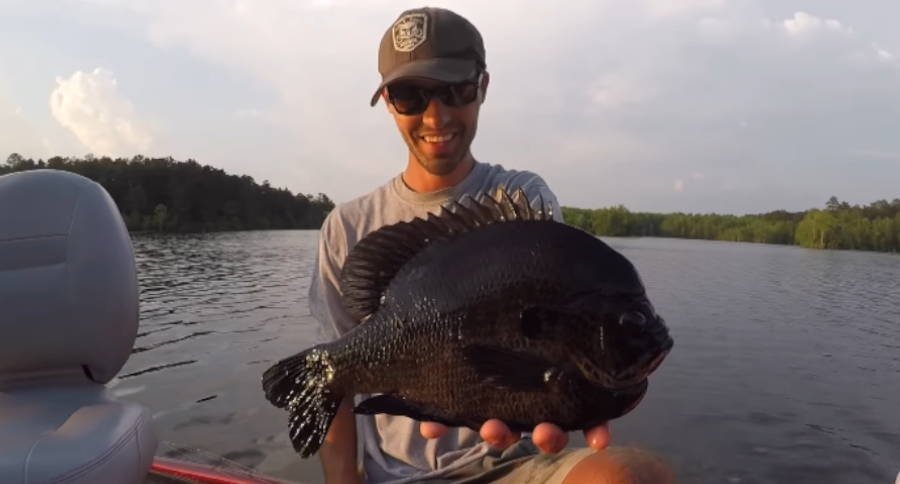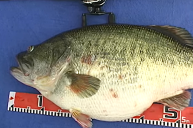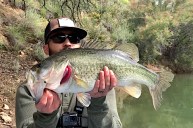Here's our best guesses on where the next world record bluegill will be caught.
Who doesn't love the bluegill? Is there another freshwater fish that is more American? These panfish are fun, easy to catch, and they are great eating. Plus they can be found just about everywhere.
But the big challenge is finding the truly big bluegills, the ones two pounds or larger.
Even more difficult than that is finding a bluegill of world record proportions. It has been almost 69 years since a world record has been caught.
In the past we've told you where we think the next world record largemouth bass and smallmouth bass will be caught. Here are our five best guesses for the all-tackle bluegill record to be broken.
1. Richmond Hill Lake, North Carolina
This one might be a little controversial for this list. First off, there is no denying the lake is filled with bluegill of ridiculous proportions. The controversial part is the fact that this is basically a private lake that has been specifically managed for huge bass and bluegill. This may draw some comparisons to high fence hunting for whitetails.
But the International Game Fish Association doesn't discriminate against fish caught from farm ponds or private lakes and until they do, that makes Richmond Hill Lake a real possibility for a world record catch. Two-pound bluegill are common here, which is crazy to think about.
While anyone can book a day of fishing here, it's going to cost you around $600 a day. But man, does this lake look like fun from the countless videos posted online for the spectacular fishing in its waters!
2. Lake Havasu/Colorado River, Arizona/California
https://www.instagram.com/p/BcNv13UBjEc/
This lake has become very well known in the last decade or so as a world-class redear sunfish factory. Hector Brito caught the world record, a 5.78-pounder, from this spot in 2014. And that wasn't the only giant being pulled from the waters. Fisheries biologists were initially puzzled when anglers suddenly started pulling monster after monster from the clear waters on the Arizona/California border.
Now there is speculation that since invasive quagga mussels were discovered in the lake in 2007, that the sunfish and bluegills have taken a liking to the taste of them. I guess that's one semi-positive outcome of an invasive species showing up. It is now believed the sunfish have been pigging out on the mussels.
If that's the case, it seems the bluegill are feasting on them too. In 2017, Sherry McDonald and her husband were fishing Thompson Bay when she pulled in a monstrous 16-inch bluegill that weighed around three pounds. The fish was never officially weighed, but there is speculation it could have broken the Colorado River record.
In any case, it has definitely made Lake Havasu and the Colorado River a hotspot for anyone seeking a world-class panfish.
3. Ketona Lake, Alabama
https://www.instagram.com/p/1Qc1FRqjjY/
This lake, created by a flooded quarry in Birmingham, Alabama, holds the claim to fame for big bluegill fishing. It is home to not one, but two world records.
In 1947, Coke McKenzie re-defined how big bluegill could get when he landed a monstrous 4-pound, 10-ouncer out of the lake. The craziest thing about this story was how the fish spent 20 hours in a fridge before being officially weighed. There is no doubt it lost a lot of weight in that time. Still, the fish smashed the current record at the time, which was only a little over two pounds.
But McKenzie's record didn't last long. Just three years later, T.S. Hudson went out fishing at the same lake on Easter Sunday in 1950 when he caught a 4-pound, 12-ounce bluegill that still stands as the record to this day.
The only issue with this lake is going to be getting access. From my research online, it seems access to the lake today may be difficult, if not impossible. Threads on Alabama fishing forums speculate the area may be private property and may be closed entirely to fishing. Who knows what may be swimming around in this quarry, especially if it hasn't had much fishing pressure in recent years?
I managed to dig up plenty of videos of people swimming and jumping off the limestone cliffs online, so people are still going in there. A determined angler might be able to get permission to go in with enough persistence.
4. C.J. Strike Reservoir, Idaho
https://www.instagram.com/p/BoLMkMPBGSx/
One of the big things you run into when diving into the biggest in bluegill fishing history is just how small the waters these fish are often caught on. That's not the case with the 7,500-acre C.J. Strike Reservoir. This lake has been gaining reputation as an awesome place for crappie, perch and, of course, bluegill.
The lake is also home to the Idaho state record, a monstrous 3-pound, 8-ounce fish caught by Darrell Grim back in 1966. That makes the Idaho state record darn near as old as the world record.
5. Goldwater Lake, Arizona
https://www.instagram.com/p/BJqleyygwEH/
Located just outside of Prescott, this tiny, 15-acre lake produced the Arizona state record bluegill in 2004. The huge, 15-inch-long fish weighed a whopping 3 pounds, 15 ounces and was caught by Christopher Ray Mapes, making it one of only a few bluegills to get near that magical 4-pound mark since T.S. Hudson's record in 1950.
This lake is very small and has specific hours of operation. It also only allows boats with electric motors, kayaks or canoes, making it a quiet and very scenic place to go after big bluegills.
For more outdoor content from Travis Smola, be sure to follow him on Twitter and check out his Geocaching and General Outdoor Youtube Channels.
NEXT: THE 9 MOST LIKELY PLACES THE NEXT WORLD RECORD SMALLMOUTH WILL BE CAUGHT
WATCH:




